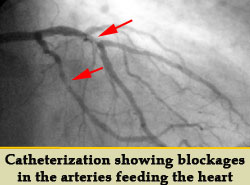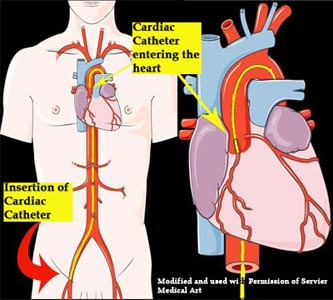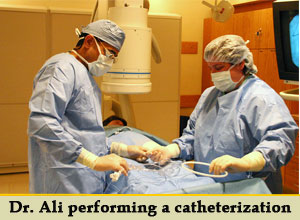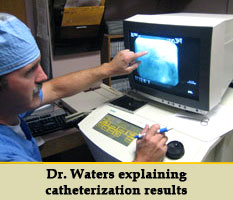 Cardiac catheterization is a procedure that can provide your cardiologist with a large amount of information about your heart. It is often considered the “gold standard” exam in regard to assessment of blockages in the arteries that feed the heart as well assessment of certain diseases which affect the aortic and mitral valves. Both blockages and valve problems can cause symptoms such as chest discomfort or shortness of breath and possibly swelling of the feet. Typically patients are scheduled for this procedure after a stress test or ultrasound of the heart is inconclusive or concerning for heart disease that may not benefit from medical therapy alone.
Cardiac catheterization is a procedure that can provide your cardiologist with a large amount of information about your heart. It is often considered the “gold standard” exam in regard to assessment of blockages in the arteries that feed the heart as well assessment of certain diseases which affect the aortic and mitral valves. Both blockages and valve problems can cause symptoms such as chest discomfort or shortness of breath and possibly swelling of the feet. Typically patients are scheduled for this procedure after a stress test or ultrasound of the heart is inconclusive or concerning for heart disease that may not benefit from medical therapy alone.
 The procedure itself takes approximately 15-30 minutes. It is performed under local anesthesia with mild to moderate sedation but not general anesthesia. (General anesthesia will increase the risk for complications with the procedure).The patient is then placed on a table in the cardiac catheterization lab and local anesthesia is administered through a small needle to the access site which is usually the radial artery at the wrist or the more traditional location of the femoral artery at the groin.
The procedure itself takes approximately 15-30 minutes. It is performed under local anesthesia with mild to moderate sedation but not general anesthesia. (General anesthesia will increase the risk for complications with the procedure).The patient is then placed on a table in the cardiac catheterization lab and local anesthesia is administered through a small needle to the access site which is usually the radial artery at the wrist or the more traditional location of the femoral artery at the groin.
 Once the catheter is placed into the arteries that feed the heart, a liquid dye (“contrast”) is injected. A camera is then placed over the chest and takes a movie. The cardiologist may have the patient hold their breath to allow the diaphragm to get out of the way for the pictures. At one point when the left ventricle (pumping chamber) is imaged, the patient may feel a hot sensation throughout the body. After the procedure, a plug is often placed in the artery to stop the bleeding, otherwise the site is compressed for about 10 or 15 minutes by hand, or a special wrist band provides compression to the radial artery. It is not a painful test. There is a mandatory bed rest period after the procedure lasting from 2 – 6 hours. The nurses and cardiologist will talk the patient through it as it happens. Most patients report that overall the anticipation of the cardiac catheterization was much worse than the actual procedure.
Once the catheter is placed into the arteries that feed the heart, a liquid dye (“contrast”) is injected. A camera is then placed over the chest and takes a movie. The cardiologist may have the patient hold their breath to allow the diaphragm to get out of the way for the pictures. At one point when the left ventricle (pumping chamber) is imaged, the patient may feel a hot sensation throughout the body. After the procedure, a plug is often placed in the artery to stop the bleeding, otherwise the site is compressed for about 10 or 15 minutes by hand, or a special wrist band provides compression to the radial artery. It is not a painful test. There is a mandatory bed rest period after the procedure lasting from 2 – 6 hours. The nurses and cardiologist will talk the patient through it as it happens. Most patients report that overall the anticipation of the cardiac catheterization was much worse than the actual procedure.
 Results of the test are known immediately and will be discussed with the patient and family members shortly after the exam has been completed. Depending on the findings, recommendations may be made for a stent/angioplasty, open heart surgery (“bypass”) or continued medical therapy. If no further are procedures are needed immediately, the patient typically goes home the same day of the procedure.
Results of the test are known immediately and will be discussed with the patient and family members shortly after the exam has been completed. Depending on the findings, recommendations may be made for a stent/angioplasty, open heart surgery (“bypass”) or continued medical therapy. If no further are procedures are needed immediately, the patient typically goes home the same day of the procedure.
What to Expect Before the Procedure:
- If you have had a reaction to contrast, shellfish or iodine in the past, please let your cardiologist know immediately.
- Nothing to eat after the midnight before the procedure.
- You may take your pills with small sips of water.
- Diabetes pills should be held and if you take insulin, ask your physician how the dose should be adjusted.
- Glucophage (Metformin®) should be withheld the day before and a few days after the procedure.
- We prefer patients to continue aspirin and plavix if previously prescribed. If you take Coumadin, please ask your cardiologist if these should be withheld before the procedure.
- You may bring a CD of your favorite music to help you relax
What to Expect After the Procedure:
- There may be soreness at the incision site and possibly some swelling and bruising.
- There may be a small, walnut-sized lump at the access site which should become smaller and becomes less tender within days
- There may be a small area of bruising following the procedure which may seem to get larger and expand down the leg. This is often seen and does not typically represent ongoing bleeding but often represents old blood under the skin which is traveling in the direction of gravity.
- Avoid any significant physical activity or heavy lifting for the first few days after the procedure.
- The patient may resume driving the day following the procedure.
- Avoid taking a bath for a few days; showers may be taken within 24 hours.
When to Call your Physician or 9-1-1:
- Bleeding at the access site. Pressure should be applied to the site by a friend/family member until medical advice is obtained.
- Severe tenderness, discharge or fever
Complications:
Complications of the procedure are rare, but could include a blood vessel tear or bleeding, reaction/allergy to medication or contrast, kidney complications or very rarely stroke or heart attack. Life-threatening complications are extremely rare.
It is our hope that a cardiac catheterization will help your cardiologist learn more about your heart to improve your health.
To learn more about Cardiac Catheterization, click here.
